![]()
Aroids and other genera in the Collection
Take the Tour Now?
Orchids
The
Exotic Rainforest
Plants in
the Exotic Rainforest Collection
The images on this website are copyright protected. Please contact us before any reuse.
Detailed information on Growing Anthurium Species
Click this Link
Within our collection we have many species of Anthurium. If you are seeking other photos, click this link.
New: Understanding, pronouncing and using Botanical terminology, a Glossary
Synonym: Anthurium marmoratum

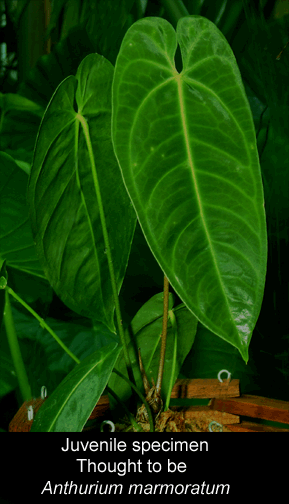 To make identifications even more complicated
juvenile specimens do not look like adult specimens and the natural variation
found within Araceae (aroids) allows a variety of leaf shapes to
develop once a specimen matures. The juvenile form of
Anthurium angamarcanum and Anthurium marmoratum appear the
same. On the evening of February 18, 2009 I received this note from Dr. Croat,
"Last night I
worked with the types of A. angamarcanum and A. marmoratum.
Although the types look identical Sodiro gave decent characters for
their separation. I suppose that if the characters he used really are
true they could be distinct. At least the one from Angamarca may be
extinct because there is no forest left in that area. It now appears
that this terrestrial species with the broadly ovate blade and free
basal veins must be new. I have made some very preliminary notes."
To make identifications even more complicated
juvenile specimens do not look like adult specimens and the natural variation
found within Araceae (aroids) allows a variety of leaf shapes to
develop once a specimen matures. The juvenile form of
Anthurium angamarcanum and Anthurium marmoratum appear the
same. On the evening of February 18, 2009 I received this note from Dr. Croat,
"Last night I
worked with the types of A. angamarcanum and A. marmoratum.
Although the types look identical Sodiro gave decent characters for
their separation. I suppose that if the characters he used really are
true they could be distinct. At least the one from Angamarca may be
extinct because there is no forest left in that area. It now appears
that this terrestrial species with the broadly ovate blade and free
basal veins must be new. I have made some very preliminary notes."
Anthurium angamarcanum is largely found within Ecuador and was originally described in 1901 by Luis Sodiro. Sodiro was a Jesuit priest serving in Ecuador who became one of the most important aroid botanists in the history of aroid species since he described many tropical aroid species. He described Anthurium marmoratum in 1903 and worked in Ecuador from 1870 to 1909 describing a total of 281 taxa of Ecuadorian Araceae, largely Anthurium species. He was the first botanist specializing in aroids to be considered a field botanist and spent most of his career in the Ecuadorian tropics. Born in Italy in 1836, Sodiro served in Ecuador until the time of his death.
Unknown to early botanists numerous Anthurium sp. frequently have variations in their appearance. In addition, numerous botanical records have pointed out confusing information in Sodiro's notes since he gave different names to several Anthurium specimens which have since proven to be a single species. Aroids are variable in appearance so if you are not aware of the natural variation within aroids please read this page.
An aroid, all Anthurium species reproduce via the production of an inflorescence and that inflorescence is supported by a stalk known as the peduncle. When an Anthurium is "in flower" the reference is to the tiny male, female, and sterile male flowers that grow on the spadix at the center of the inflorescence. The spathe of an aroid is not a "flower" but instead is a modified leaf. The spadix at its center of the inflorescence vaguely resembles an elongated pine cone. The spadix is a spike on a thickened fleshy axis which can produce tiny flowers. When at sexual anthesis, once the female flowers on the spadix are ready to reproduce they must be pollinated by an insect which is normally a beetle that is a member of the genus Cyclocephala. That insect transfers pollen from another specimen of the same species currently at male anthesis to a specimen that is at female anthesis and now receptive. A link to information from aroid expert Julius Boos can be found at the end of this paragraph should you wish to learn how aroids are pollinated in nature. If pollinated the female flowers will produce berries containing seeds. The berries are then eaten by birds and other rain forest animals that spread them among the forest in their droppings. Aroid pollination
At present Dr. Croat appears to believe our specimen (shown below) as well as one in the collection of Dr. Ron Kaufmann in San Diego, CA may be a new species which he is currently calling Anthurium marmoratum until a final determination can be made. The story of that possible determination is told here: Anthurium marmoratum. Our specimen is still in the juvenile stages and no final determination is possible at this time. Dr. Kaufmann provided this comment regarding this group of plants: "There seem to be two distinctly different species that have been called A. angamarcanum and A. marmoratum by growers. I don't know how either of those names relates to the two species that Sodiro described in the early 1900's. For simplicity/consistency, I'm referring them as A. angamarcanum and A. marmoratum, as you have on your page. I have photos on my web site of mature plants of both species. Go to http://home.sandiego.edu/~kaufmann/aroids/anthurium.html and click on the appropriate names on the left-hand navigation menu. In particular, pay attention to the nature of the roots and the inflorescences, which differ distinctly between the two species"
If you have photos of either Anthurium angamarcanum and/or Anthurium marmoratum you will be willing to share with us for this study please email them in as high resolution as possible to Steve@ExoticRainforest.com Please include as much detail of the leaf blades, veins, petioles, cataphylls, stem, and inflorescence as possible. Photos of these species taken in either Colombia or Ecuador are very valuable and much appreciated but please be sure and include the location where the photos were taken. You will be credited for any photo used.
A synopsis of Dr. Tom
Croat's published field notes on Anthurium angamarcanum from TROPICOS
Anthurium angamarcanum grows
as a hemiepiphyte, terrestrial or an
appressed epiphytic species. Both hemiepiphytes and
epiphytic species are found growing on trees while appressed indicates
the plant is growing pressed tightly to the host.
The
petioles that support each leaf blade are dark green while reddish
at the base and almost matte as well as obtusely to
conspicuously sulcate. Sulcate is defined as either to have a
sulcus (canal) or tiny parallel grooves running along the axis.
The
petioles are matte and conspicuously striated as well as flattened adaxially
(on the upper surface). Striation indicates parallel lines running
along the petiole. The petiole may also be weakly sulcate medially, or in the
center. The petioles can be either flattened adaxially (on the upper
surface) or terete (round).
Despite common
misconceptions the petiole is not the "stem", a term commonly
incorrectly used by collectors. The petiole is the stalk which connects
the leaf blade to the stem which is at the base of the plant.
In botanical science the
stem is the "cane" at the base of the plant and the petioles with their
new leaves grow from the nodes along the stem. Between each node
is a segment known as an internode. The roots of
Anthurium species also emerge from the stem.
The internodes along the stem of
Anthurium angamarcanum are short measuring from 1 to 6 cm in length
as well as .6 to 4 cm in diameter. The internodes are pale green to
light brown in color as well as weakly glossy.
The cataphylls are pinkish tinged
turning brown with pale fibers exposed at the base and are persistent
remaining semi-intact once dried with
pale fibers but eventually become deciduous and fall from the plant.
A cataphyll is a bract- like modified leaf that surrounds any new leaf
and whose purpose is to protect the emerging leaves as they develop.
As described,
Anthurium angamarcanum like
Anthurium marmoratum must possess long blades ca.
2.3 to 2.6 times longer than broad.
The leaf
blades of Anthurium angamarcanum are subcoriaceous (less than
leathery to the touch) and dark green as well as velvety adaxially (above).
The blade is paler and weakly
glossy to matte abaxially (below). The midrib is acute
(gradually tapering to a point) and
slightly paler above as well as convex and sharply three ribbed below.
The
primary lateral veins are both raised and acute on both sides.
The tertiary or minor veins are partially sunken above but raised below.
My thanks to Leland Miyano, Dr. Ron
Kaufmann, and Dr. Croat for their input. When
viewing the photos below please refer to the assigned accession number
followed by a letter to understand what you are viewing. The
initials are those of the photo provider while the letter indicates the
location or appropriate part of the plant. A= Habit, B=
petiole, C= cataphyll, D= stem, E= leaf, F= venation, G=
inflorescence
Specimen
LM0001 This
specimen of Anthurium angamarcanum is in the collection
of Leland Miyano in Hawaii and is grown terrestrially. The
blade measures approximately 2 feet (60 cm).
The specimens in his notes were observed in southern Colombia and 5
locations around Ecuador: The geniculum of
Anthurium angamarcanum at the top of the petiole is narrowly
sulcate. The
geniculum is found at the top of the petiole and allows the leaf blade
to rotate and orient itself to find a brighter source of light.
The geniculum looks and works something like an elbow. Just like
your elbow allows you to bend and rotate your arm, the geniculum allows
the leaf of an
Anthurium to rotate itself up, down or from side to side in
order to better collect light. The geniculum may be
swollen and obvious in some species but barely noticeable except
to the touch in others. It is not uncommon for the
geniculum to have scarring from age.
The geniculum of
Anthurium angamarcanum at the top of the petiole is narrowly
sulcate. The
geniculum is found at the top of the petiole and allows the leaf blade
to rotate and orient itself to find a brighter source of light.
The geniculum looks and works something like an elbow. Just like
your elbow allows you to bend and rotate your arm, the geniculum allows
the leaf of an
Anthurium to rotate itself up, down or from side to side in
order to better collect light. The geniculum may be
swollen and obvious in some species but barely noticeable except
to the touch in others. It is not uncommon for the
geniculum to have scarring from age.
The
inflorescence of Anthurium angamarcanum is erect with the spathe green
in color. The blade is spreading-reflexed (turning backwards)
while the spadix is
medium to dark green to reddish purple and weakly glossy in sheen.
The fruit is green.
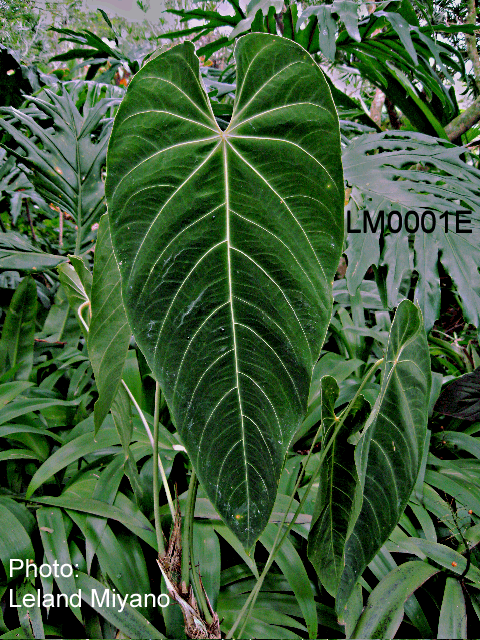
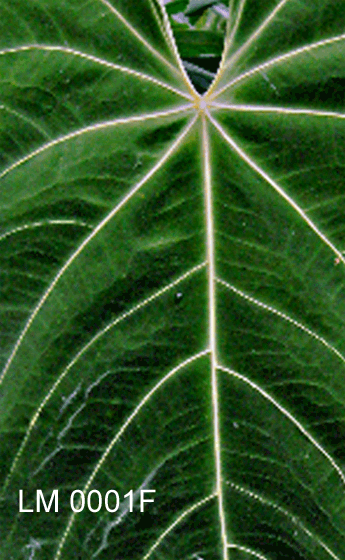
Specimen RK0002
This specimen is in the
collection of Dr. Mardy Darian and was photographed by Dr. Ron
Kaufmann.
To join the
International Aroid Society click here:
http://www.exoticrainforest.com/Join%20IAS.html
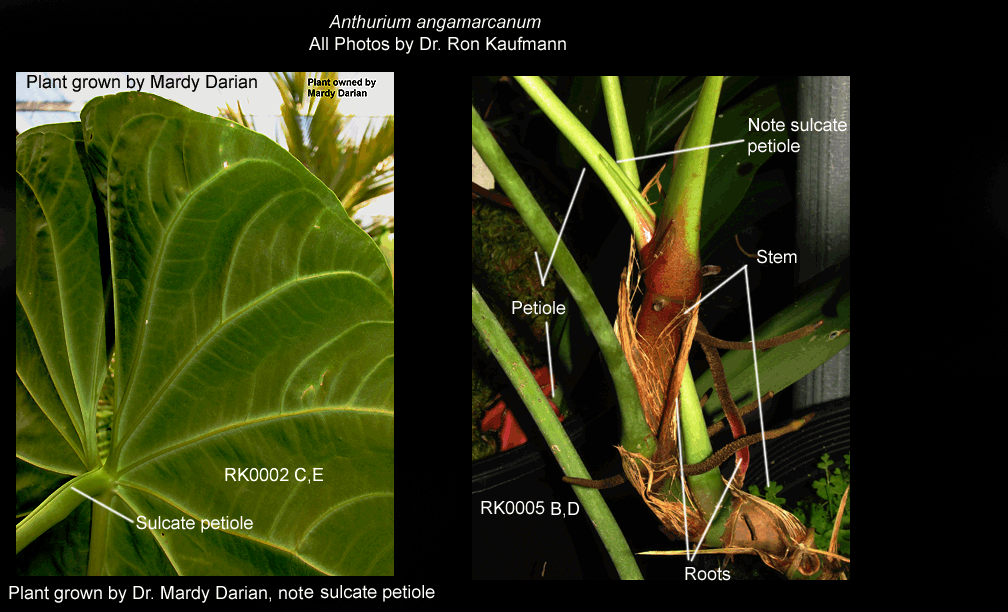
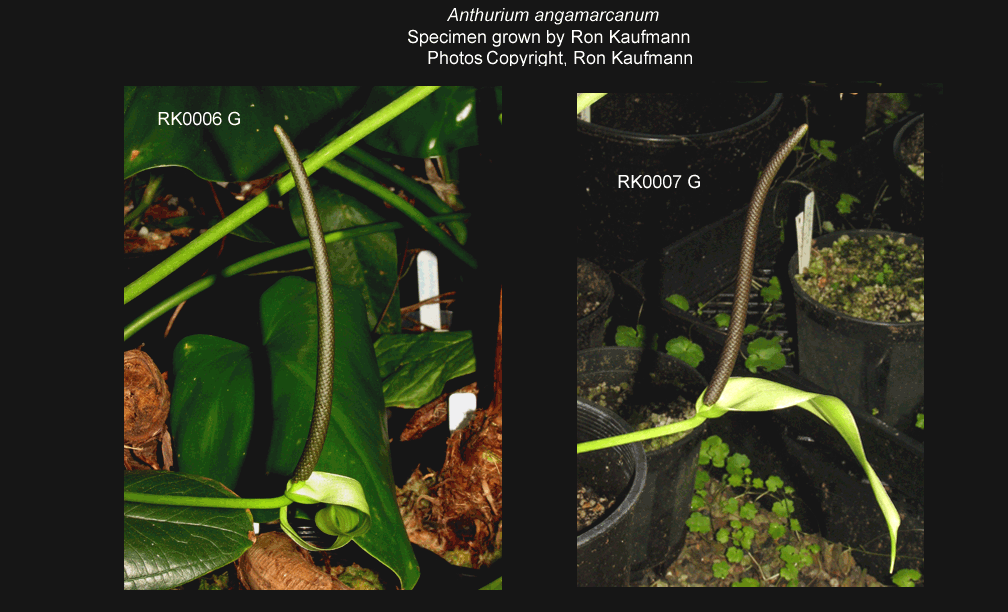
Need more information on Anthurium species? Click this link.